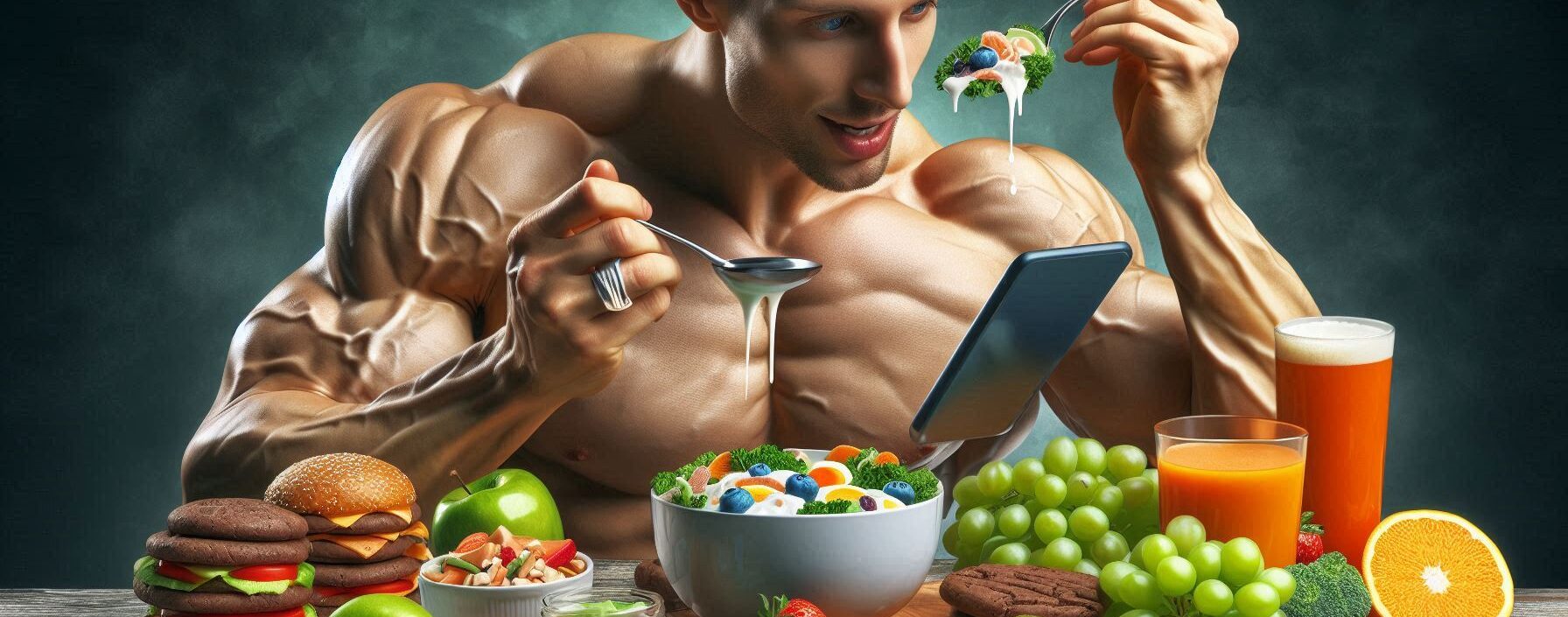Please Note: This post may contain affiliate links. If you click one of them, we may receive a commission at no extra cost to you. As an Amazon Associate, I earn from qualifying purchases.

So, you’ve decided it’s time to shed a few pounds while keeping those muscles looking like they belong on a Greek statue. Good for you! This is no small feat; it’s like trying to eat just one potato chip—impossible!
But fear not, dear reader, because I’m here to guide you through the maze of healthy eating without losing your hard-earned gains.
Top Takeaways and Key Concepts
Create a small calorie deficit to lose fat without sacrificing muscle mass.
Eat enough protein daily to preserve muscle and stay full longer.
Prioritize nutrient-dense foods like lean proteins, vegetables, whole grains, and healthy fats.
Fuel workouts smartly with balanced pre- and post-workout meals for better performance and recovery.
Stay hydrated consistently to support metabolism, energy, and muscle function.
Summary of This Article
This article explains how to lose body fat while preserving muscle through smart nutrition choices. It emphasizes calculating daily calorie needs and creating a moderate deficit to promote sustainable fat loss. Prioritizing high protein intake is vital for maintaining muscle, while nutrient-dense foods support satiety and overall health. Proper meal timing—especially around workouts—helps with performance and recovery, and hydration plays a key role in energy and fat-burning efficiency. Finally, it encourages tracking progress sensibly without obsessing over the scale, focusing instead on long-term habits and results.
Video Summary
Shortcuts to Exercise Equipment Shopping at Amazon
Ellipticals - Exercise Bikes - Recumbent Bikes - Treadmills - Rowers
Dumbbells - Resistance Bands - Kettlebells - Benches - Pull-up Bars
1. Understanding Your Caloric Needs
First things first: let’s talk about calories. You might be thinking, “Calories? Aren’t those the little devils that make my jeans tighter?” Well, yes and no. Calories are simply units of energy, and if you want to lose fat while keeping muscle mass intact, understanding how many you need is crucial.
To figure this out, start by calculating your Total Daily Energy Expenditure (TDEE). It sounds complicated but think of it as figuring out how many cookies you can eat before your mom finds out.
Your TDEE takes into account your basal metabolic rate (the calories burned at rest) plus any activity level—like lifting weights or chasing after ice cream trucks.
Once you know your TDEE, aim for a caloric deficit—eating fewer calories than you burn. A deficit of about 500 calories per day can help you lose roughly one pound a week. Just remember: starving yourself won’t work; we’re aiming for sustainable changes here!
2. Prioritize Protein Intake
Now that we’ve tackled calories, let’s dive into protein—the magical nutrient that helps preserve muscle while losing fat. Honestly, if protein were a person at a party, it would be the life of the event!
Aim for around 1.6 to 2.2 grams of protein per kilogram of body weight each day—that’s about 0.7 to 1 gram per pound if you’re still awake from all those numbers! High-protein foods include chicken breast, fish, beans, tofu… basically anything that doesn’t run away when you approach it with a fork.
Eating enough protein helps prevent muscle loss during calorie restriction and keeps you feeling full longer—a win-win situation! Plus, who doesn’t love an excuse to chow down on steak or chickpeas?
3. Choose Nutrient-Dense Foods
Next up: nutrient-dense foods! These are foods packed with vitamins and minerals relative to their calorie content—a fancy way of saying they give more bang for your buck (or bite). Think colorful fruits and veggies rather than sad-looking processed snacks.
When planning meals for fat loss while maintaining muscle mass, focus on whole foods like leafy greens (because who wouldn’t want Popeye arms?), lean proteins (see above), whole grains like quinoa or brown rice—and don’t forget healthy fats like avocados or nuts!
These foods not only nourish your body but also keep cravings at bay so that late-night cookie raid becomes less tempting—or at least more manageable!
4. Timing Matters: Meal Frequency and Pre/Post-Workout Nutrition
You might have heard conflicting advice about meal timing—some say eat five small meals throughout the day; others swear by intermittent fasting as though it’s some secret cult ritual involving kale smoothies.
Honestly? It’s all about what works best for YOU! Some people thrive on frequent meals; others prefer two larger ones and maybe an occasional snack in between—like cheese puffs during Netflix marathons (not recommended).
But speaking of timing… pre- and post-workout nutrition matters too! Before workouts, fuel up with carbs and protein so you’re energized enough not to look like Bambi on ice during squats. Afterward? Refuel with protein within two hours—it’ll help repair those muscles faster than I can say “I should really stop eating chips.”
5. Stay Hydrated Like You’re Training for a Water Olympics
By the way, hydration plays an important role in both fat loss and muscle maintenance—you wouldn’t want your muscles drying up like old sponges in the sun now would you? Aim for at least eight glasses of water daily; however much exercise you’re doing may require even more!
Hydration affects performance levels too—dehydration can lead to fatigue faster than watching paint dry! So, grab that water bottle; consider it an extension of yourself as vital as oxygen… okay maybe not quite THAT dramatic—but close!
6. Monitor Progress Without Obsession
As we wrap this feast of knowledge up (pun intended), let’s talk progress tracking without becoming obsessed over every single number on the scale or measuring tape—not everything has to revolve around math class!
Consider taking progress photos instead—they capture changes better than numbers ever could—and sometimes reflect how far you’ve come without making us feel guilty about last weekend’s pizza binge.
Also keep track of how clothes fit rather than stressing over fluctuating scales because guess what? Muscle weighs more than fat but takes up less space…so put away that calculator already!
Suggested Resources:
How Many Calories Should You Eat Per Day?
https://www.healthline.com/nutrition/how-many-calories-per-day
The Importance of Protein for Weight Loss
https://www.bodybuilding.com/content/the-importance-of-protein-for-weight-loss.html
Meal Timing and Frequency in Healthy Adults
https://www.ncbi.nlm.nih.gov/pmc/articles/PMC6520988/
Frequently Asked Questions
How can I lose fat without losing muscle?
Create a small calorie deficit instead of extreme restriction so your body has enough energy to maintain muscle tissue while still burning fat.
How important is protein when trying to keep muscle during fat loss?
Protein is critical because it supports muscle repair and helps preserve lean mass even while calories are reduced.
What types of foods should I eat to support fat loss and muscle?
Focus on lean protein, whole grains, vegetables, fruit, and healthy fats because they offer high nutrition with better fullness and satiety.
Should I eat before and after workouts when trying to maintain muscle?
Yes, consuming protein and carbs pre- and post-workout helps fuel performance and improves recovery so muscle is better protected.
How much water should I drink when trying to lose fat?
Most people benefit from drinking water consistently throughout the day because hydration supports energy, metabolism, and muscle function during training.
Is it better to eat more meals or fewer meals per day?
Meal frequency is personal and both approaches can work as long as calories, protein, and nutrients remain consistent.
Should I track progress daily while losing fat?
No, daily fluctuations are normal so it’s better to assess weekly or through photos and clothing fit rather than only scale numbers.

Kevin Collier is a passionate fitness expert dedicated to helping individuals achieve their health and wellness goals. With a focus on weight lifting, exercise routines, and effective weight loss strategies, he aims to inspire and motivate others on their fitness journeys. Through evidence-based insights and practical advice, Kevin empowers readers to make informed decisions about their health, encouraging a balanced approach to fitness and overall well-being. Whether you’re a beginner or an experienced athlete, his expertise offers valuable guidance to elevate your fitness game.




